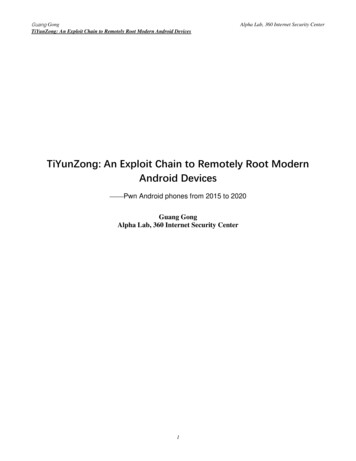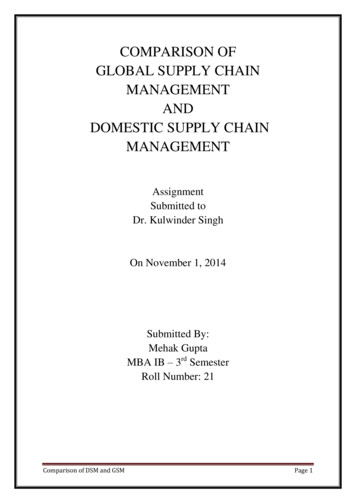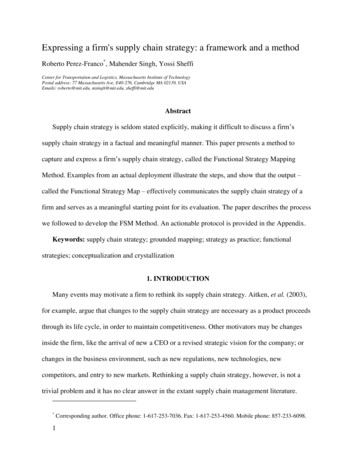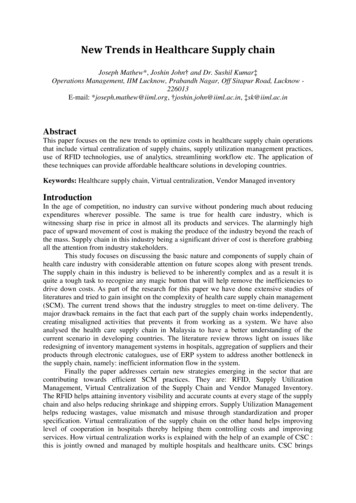
Transcription
Guang GongAlpha Lab, 360 Internet Security CenterTiYunZong: An Exploit Chain to Remotely Root Modern Android DevicesTiYunZong: An Exploit Chain to Remotely Root ModernAndroid Devices——Pwn Android phones from 2015 to 2020Guang GongAlpha Lab, 360 Internet Security Center1
Guang GongAlpha Lab, 360 Internet Security CenterTiYunZong: An Exploit Chain to Remotely Root Modern Android DevicesContentTiYunZong: An Exploit Chain to Remotely Root Modern Android Devices . 1——Pwn Android phones from 2015 to 2020 . 1ABSTRACT . 3Keywords . 3Background . 3Remote Attack Surface And Releated Works . 4The Exploit Chain . 5The RCE Vulnerability (CVE-2019-5877) . 7Prior Knowledge . 7Where is The Bug . 7How to Exploit it . 9The EOP Vulnerability (CVE-2019-5870) . 9Prior Knowledge . 9Where is The Bug . 10How to Exploit it . 12The Root Vulnerability (CVE-2019-10567) . 13Prior Knowledge . 13Where is The Bug . 15How to Exploit it . 16Conclusion . 20REFERENCES . 212
Guang GongAlpha Lab, 360 Internet Security CenterTiYunZong: An Exploit Chain to Remotely Root Modern Android DevicesABSTRACTAs more and more mitigations have been introduced into Android, it has become much more difficult to root modern Androiddevices, in particular, remotely root. This is especially true for Pixel devices as they always have the latest updates andmitigations. In this paper, we will explain why Pixel devices are challenging targets and will give a comprehensive attacksurface analysis of remotely compromising Android. Furthermore, we will introduce an exploit chain, code-namedTiYunZong, which can be leveraged to remotely root a wide range of Qualcomm-based Android devices including PixelDevices. The name TiYunZong comes from a very famous Chinese martial arts fiction and this Kungfu allows people tomove upward swiftly and effortlessly as if clouds are the stairs. The exploit chain includes three bugs which are just like thecloud stairs of TiYunZong.The three bugs are found lately and they are numbered CVE-2019-5870, CVE-2019-5877, CVE-2019-10567. We will alsopresent an effective and stable approach to chain these three vulnerabilities for exploitation without any ROP, despite the factthat ROP is the most common technique to exploit complicated vulnerabilities. The exploit chain is the first reported oneclick remote root exploit chain on Pixel devices and won the highest reward for a single exploit chain across all Google VRPprograms[1].KeywordsAndroid, Chrome, Root, Remote Code Execution, Exploitation, V8, Mojo, KGSLBACKGROUNDWhich is the most secure smartphone? It’s an open question and I think there is no standard answer. But I will try to convinceyou that Pixel phone is at least one of the most secure smartphones.Android and iOS are the two most popular mobile operating systems in the world, and there are too many arguments aboutwhich is more secure. There are different answers from different perspectives. If we answer the question from the perspectiveof the price paid by vulnerability brokers, Android is more secure as higher bounty suggests greater threat the vulnerabilitymay pose and more difficulties to discover it.Figure 1. Part of ZERODIM Payouts for MobilesAs indicated in Figure 1, Zerodium pays up to 2.5 million for Android FCP Zero-click, which is higher than IOS FCP Zeroclick. We can say Android is more secure than iOS to some extent.3
Guang GongAlpha Lab, 360 Internet Security CenterTiYunZong: An Exploit Chain to Remotely Root Modern Android DevicesIf we assume Android is more secure than iOS, the remaining question is which is the most secure phones among Androidphones. It’s easier to answer than the previous one. Google Pixel devices often have more up-to-the-date OS versions,security patches and vulnerability mitigations than other Android phones, which make it more difficult to be attacked.As shown in Table 1, the Pixel phone is the only device that was not pwned in last three years’ Mobile Pwn2Owncompetitions [2][3][4] while Apple iPhone devices were pwned 7 times in total. Other Android devices including SamsungGalaxy devices, Huawei Mate/P series and Xiaomi Mi Devices were Pwned several times in the contests too. Many exploitsdemonstrated in the contests target Android devices existed in outdated OS component or unsecured customized code.DevicesPwned TimesApple iPhoneGoogle PixelSamsung GalaxyHuawei Mate/PXiaomi MiMobile Pwn2Own 20175(1 partial win)032N/AMobile Pwn2Own 201820205Mobile Pwn2Own 2019003(1 partial win)03(1 partial win)Total7Year082Table 1. Mobile Pwn2Own results of the latest three years8According to price the vulnerability brokers offer and the results of the Mobile Pwn2Own competitions, Google Pixel Phoneis one of the most secure smartphones. It’s a tough target, however no device is 100% invulnerable. In this paper, I’ll detailhow I remotely root the pixel phone.REMOTE ATTACK SURFACE AND RELEATED WORKSRemotely compromising a smart phone is very appealing for bug bounty hunters and there have been some interestingresearches in recent years. As shown in figure 2, remote attacks of smart phones can be divided into two categories by attackvector: attacks through internet and attacks through adjacent network.InternetNetworkAdjacentNetworkFigure 2. Remote Attack Surface of smart phonesNormally speaking, attacks exploiting vulnerabilities in browsers, IMs and emails can be launched through internet. Attackswhich exploits vulnerabilities in NFC, Bluetooth, Wi-Fi and baseband are mostly launched through adjacent network. Attacksfrom internet is more destructive than attacks from adjacent network. But the former often needs some interaction, such as4
Guang GongAlpha Lab, 360 Internet Security CenterTiYunZong: An Exploit Chain to Remotely Root Modern Android Devicesclicking a URL, opening an email or instance message. It’s relatively easier to launch an attack from adjacent networkwithout interaction than from internet, Broadpwn[5] and BlueBorne[6] are amazing adjacent network attacks. It’s hard to saywhich attack is more harmful between zero-click adjacent network attack and one-click internet deployable attack.The exploit chain I used to remotely root the pixel phone is a one-click internet deployable attack chain. Table 2 summarizessome remote working exploit chains found by me targeting Android in recent years.EventAttack VectorTarget PhoneObtained PermissionsPwn2Own 2015Chrome v8 bug- RCE2UXSS- Google Play InstallNexus 6Install any appPwn0Rama 2016Chrome v8 bug - Chrome IPC weakness- WebViewbugNexus 6P,Galaxy Note5,LG G4Install any appPwnFest 2016Chrome v8 bug - RCE2UXSS- Google Play InstallPixel XLInstall any appPwn2Own 2017Samsung Internet Browser bug - exynos grallocmodule bugGalaxy S8System user permissionASR 2018Chrome v8 bug - libgralloc module bugPixelSystem user permissionASR 2019Chrome v8 bug - Mojo IPC bug- KGSL bugPixel 3Root user permissionTable 2. Remote working exploit chains targeting Android Found by me in recent yearsIn Mobile Pwn2Own 2015, I pwned Nexus 6 with a single vulnerability [7], which is an OOB access bug(CVE-2015-6764)in v8 JavaScript Engine, to get RCE in Chrome render process. Then I turned this RCE into an UXSS vulnerability, so anyJavaScript code could be injected into Google play website and any app could be installed from it.In Pwn0Rama 2016, I pwned Nexus 6P, Galaxy Note 5, LG G4 with a single exploit chain [8], the exploit chain also startedfrom a v8 bug, combined with a Chrome IPC weakness: any exported activity including webview activity in system could belaunched by JavaScript. At that time, the webview in Android had no sandbox, by exploiting the v8 bug again in a webview,Chrome sandbox could be bypassed easily. This sandbox escaping method doesn’t work anymore because webview is alsosandboxed now.In PwnFest 2016, I pwned a Pixel XL with a single vulnerability once more [9], I exploited a small logical mistake (CVE2016-9651) in v8, and then I leveraged the same RCE2UXSS method used in Pwn2Own 2015 to install apps from Googleplay. After PwnFest 2016, Google updated the remote app installation feature to prompt the user to enter their password,which makes this form of attack difficult [10], but it took more than a year for them to mitigate this kind of attack. As ofChrome 77, Site Isolation has been enabled on Android devices with at least 2 GB of RAM [11]. It’s nearly impossible toleverage the RCE2UXSS method.In Mobile Pwn2Own 2017, I pwned a Galaxy S8 with two bugs [12], an OOB access bug in Samsung Internet Browser, and aUse-After-Unmap vulnerability in Samsung exynos gralloc module. Due to the existence of Selinux, most system services inAndroid are restricted from being accessible from the sandboxed Chrome rendering process, and only a few functions can becalled from the isolated app domain. It's a narrow attack surface from sandbox render processes to system services. But Istill found a way that let renderer process reach system server by binder call with Parcelable object [13]. I can get a reverseshell with system user permission through this exploit chain.In Android Security Reward Program 2018, I Pwned Pixel phone with two bugs (CVE-2017-5116 and CVE-2017-14904).CVE-2017-5116 is a V8 engine bug that is used to get remote code execution in sandboxed Chrome render process. CVE2017-14904 is a bug in Android's libgralloc module that is used to escape from Chrome's sandbox. Together, this exploitchain can be used to inject arbitrary code into system server by accessing a malicious URL in Chrome. This exploit chainwon the highest reward in the history of the ASR program [14].In Android Security Reward Program 2019, I pwned Pixel 3 with three bugs, which are CVE-2019-5870, CVE-2019-5877,CVE-2019-10567. It won the highest reward for a single exploit chain across all Google VRP programs.THE EXPLOIT CHAINThe exploit chain is composed of 3 bugs, two Chrome bugs and one QUALCOMM KGSL driver bug. The attack vector ismalicious links. Once victims access a web link controlled by attackers, the attacker can get a reverse shell with root privilegeof the attacked phone. Figure 3 shows how to remotely get root permission with the exploit chain.5
Guang GongAlpha Lab, 360 Internet Security CenterTiYunZong: An Exploit Chain to Remotely Root Modern Android DevicesFigure 3. the Exploit ChainFirst, an OOB access bug (CVE-2019-5877) in v8 is exploited to achieve remote code execution in a Chrome render process,render process runs in the SELinux domain iosolated app and is highly sandboxed. According to the following SELinuxpolicies [15], we know render processes can only interact with three Android system services: activity service, displayservice and webview update service, and it can’t access the GPU driver directly.# Isolated apps can only access three services,# activity service, display service, webviewupdate service.neverallow isolated app {service manager type-activity service-display service-webviewupdate service}:service manager find;# Isolated apps shouldn't be able to access the driver directly.neverallow isolated app gpu device:chr file { rw file perms execute };CVE-2019-10567 is a bug in QUALCOMM GPU driver, but it can’t be triggered directly from islolated app domain. Inorder to trigger this bug, we need to escape from islolated app domain with the help of CVE-2019-5870 firstly. CVE-20195870 is a use-after-free vulnerability in the media component. A compromised render process can trigger this vulnerabilitythrough Mojo call [16]. By exploiting it, arbitrary code can be executed in Chrome privileged process. This process runs inthe SELinux domain untrusted app. As the following SELinux polices [17] shown, process run in this domain can accessGPU driver.# Grant GPU access to all processes started by Zygote.# They need that to render the standard UI.allow { appdomain -isolated app } gpu device:chr file rw file perms;The domain untrusted app is still restricted by Android application sandbox. We need another bug to break applicationsandbox.6
Guang GongAlpha Lab, 360 Internet Security CenterTiYunZong: An Exploit Chain to Remotely Root Modern Android DevicesGenerally speaking, normal apps including Chrome can’t access most of drivers in Andoid because of the existence ofSELinux. To root Android from an app, we often need to find a bug in android system service and then exploit it as a proxyto attack the kernel. Luckily, the KGSL driver bug (CVE-2019-10567) I found can be triggered from Chrome privilegedprocess directly. It’s a configuration issue in the QUALCOMM Adreno GPU kernel driver. There is a way to deceive theGPU kernel driver into thinking there is room in the GPU ring buffer and overwriting existing commands could allowunintended GPU opcodes to be executed [18]. the following chapters will introduce the technical details of the threevulnerabilities in the exploit chain.THE RCE VULNERABILITY (CVE-2019-5877)Prior KnowledgeV8 is the JavaScript engine that powers Google Chrome. V8’s CodeStubAssembler is a custom, platform-agnostic assemblerthat provides low-level primitives as a thin abstraction over assembly [19]. V8 torque [20] is a V8-specific domain-specificlanguage that is translated to CodeStubAssembler. In V8, many JavaScript built-in functions and objects are implemented byV8 Torque.Figure 4. the Build Process of Torque [21]Figure 4 shows the build process of torque code. If there is any bug in torque code, it’ll be propagated to the generated CSAcode and then to the generated snapshot file in the end. The snapshot file is embedded into Chrome to speed up theinitialization of all built-in functionality in V8’s heap.Where is The BugThe JSFunction object in V8 is the internal representation of function in JavaScript. The size of the JSFunction object isflexible. It may contain the field PrototypeOrInitialMap or not. The field PrototypeOrInitialMap is the last field ofJSFunction if it has. Listing 1 shows the field information of the Array function. In line 15, has prototype slot means theArray function has the field PrototypeOrInitialMap (line 7), so its size is 64 bytes (line 12). Note that Array is a constructor(line 14, line 16). Listing 2 shows the field information of the function parseInt, it has no prototype slot (), so its size is 56bytes (line 6). Note that parseInt is not a constructor. Mostly, a function has prototype slot when being a constructorotherwise it does not. But there is an exception, as Listing 3 shown, the function Proxy is a constructor (line 13), but it has noprototype slot (line 6).7
Guang GongAlpha Lab, 360 Internet Security CenterTiYunZong: An Exploit Chain to Remotely Root Modern Android Devices1 d8 %DebugPrint(Array);2 DebugPrint: 0x2b7bcbd91b79: [Function] in OldSpace3 - map: 0x2f2f62402ff1 Map(HOLEY ELEMENTS) [FastProperties]4 - prototype: 0x2b7bcbd82091 JSFunction (sfi 0xc83e79480e9) 5 - elements: 0x3b058dc40bf9 FixedArray[0] [HOLEY ELEMENTS]6 - function prototype: 0x2b7bcbd91dc9 JSArray[0] 7 - initial map: 0x2f2f62403041 Map(PACKED SMI ELEMENTS) 8 - shared info: 0x0c83e79547c9 SharedFunctionInfo Array 910 0x2f2f62402ff1: [Map]11 - type: JS FUNCTION TYPE12 - instance size: 6413 - callable14 - constructor15 - has prototype slot16 - constructor: 0x2b7bcbd822e1 JSFunction Function (sfi 0xc83e7954449) Listing 1. The Field Information of Array1 d8 %DebugPrint(parseInt)2 DebugPrint: 0x2b7bcbd8b999: [Function] in OldSpace3 - map: 0x2f2f624003e1 Map(HOLEY ELEMENTS) [FastProperties]4 - prototype: 0x2b7bcbd82091 JSFunction (sfi 0xc83e79480e9) 5 - elements: 0x3b058dc40bf9 FixedArray[0] [HOLEY ELEMENTS]6 - function prototype: no-prototype-slot 7 - shared info: 0x0c83e79557a1 SharedFunctionInfo parseInt 8910 0x2f2f624003e1: [Map]11 - type: JS FUNCTION TYPE12 - instance size: 5613 - callable14 - constructor: 0x3b058dc401b1 null Listing 2. The Field Information of parseInt1 d8 %DebugPrint(Proxy)2 DebugPrint: 0x2b7bcbd8d6d1: [Function] in OldSpace3 - map: 0x2f2f62401d31 Map(HOLEY ELEMENTS) [FastProperties]4 - prototype: 0x2b7bcbd82091 JSFunction (sfi 0xc83e79480e9) 5 - elements: 0x3b058dc40bf9 FixedArray[0] [HOLEY ELEMENTS]6 - function prototype: no-prototype-slot 7 - shared info: 0x0c83e795e749 SharedFunctionInfo Proxy 89 0x2f2f62401d31: [Map]10 - type: JS FUNCTION TYPE11 - instance size: 5612 - callable13 - constructor14 - constructor: 0x3b058dc401b1 null Listing 3. The Field Information of ProxyThe RCE bug exists in toque code. It’s an OOB access vulnerability as shown in Listing 4[22]. In line 6 the MacroGetDerivedMap tries to get the field prototype or initial map of the argument newTarget, but it doesn’t check whether8
Guang GongAlpha Lab, 360 Internet Security CenterTiYunZong: An Exploit Chain to Remotely Root Modern Android DevicesnewTarget contains prototype or initial map, and accesses it directly. If newTarget happens to be the Proxy function, it isan out-of-bound access.1 macro GetDerivedMap(implicit context: Context)(2 target: JSFunction, newTarget: JSReceiver): Map {3 try {4 const constructor Cast JSFunction (newTarget) otherwise SlowPath;5 const map 6Cast Map (constructor.prototype or initial map) otherwise SlowPath;7 if (LoadConstructorOrBackPointer(map) ! target) {8goto SlowPath;9 }10 return map;11 }12 label SlowPath {13 return runtime::GetDerivedMap(context, target, newTarget);14 }15 }Listing 4. The Torque Code of RCE BugHow to Exploit itIt’s easy to trigger the bug, you need only one line of JavaScript code as follows:var malformedTypedArray Reflect.construct(Uint8Array, [4], Proxy)This line of JavaScript code creates a typed array with Reflect.construct, Uint8Array is target constructor, and Proxy isnewTarget. Reflect.construct will call the Torque function CreateTypedArray, which will call the vulnerable macroGetDerivedMap. Because the newTarget argument is set to the Proxy function, the OOB access will be triggered. But if werun the single line of JavaScript code above in Chrome, nothing special will happen although the OOB access has alreadyoccurred. Let’s review the vulnerable macro in Listing 4. After loading the OOB filed prototype or initial map (line 6), thevalue will be casted to a Map, then the map’s constructor is loaded and compared with target (line 7). Becauseprototype or initial map is the last filed of JSFucntion object, if it exists, the OOB access gets the first field of the nextobject. In V8, the first filed of an object happens to be a Map object, so the cast will succeed. But in most situation, thecomparison in line 7 will fail because the Map’s constructor is not equal to target (Uint8Array). So, execution flow will bailout to slow path, and we lost the exploitation primitive. In order to exploit this bug, we need to replace the object which liesafter the Proxy function object to an object whose Map’s constructor is Uint8Array. The exploit strategy is as follows:1. Free the object below the Proxy function.2. Re-occupy the free space with an object whose Map's (named map x) constructor is Uint8Array, and then drop allreference to Map x so that GC will mark the Map x object as white and will sweep it in scheduled sweep tasks.3. Trigger the OOB access bug before Max x get swept by GC, so the vulnerable GetDerivedMap macro won’t bail out to theslow path. The pointer of Map x will still be used in CreateTypedArray.4. After GC sweep task finished, re-occupy the freed space of Map x with a map whose constructor is Uint32Array, so wecan get a malformed typed array, its map is Uint32Array, but its layout, especially its element kind is Uin8Array type, it'seasy to implement arbitrary read and write with this malformed object.5. With the ability of arbitrary read and write, we can enable MojoJS bindings [23] and exploit the following Mojovulnerability to escalate from Chrome sandbox.THE EOP VULNERABILITY (CVE-2019-5870)Prior KnowledgeChrome uses a multi-process architecture, which isolates render processes from other privileged processes. As Figure 5[24]shown, the main process that runs the UI and manages tab and plugin processes is called as the browser process. The GPU9
Guang GongAlpha Lab, 360 Internet Security CenterTiYunZong: An Exploit Chain to Remotely Root Modern Android Devicesprocess is a process used when Chrome is displaying GPU-accelerated content. Likewise, the tab-specific processes arecalled render processes. Normally, render process has the lowest privilege, and the GPU process and the browser processhave higher privileges. Render processes are highly sandboxed and many interactions between them and the system areproxied by other privileged processes. In Android, render processes run in the domain “isolated app” and then GPU processand the browser process run in the domain “untrusted app”. The communication between processes is via inter-processcommunication. The RCE bug occurred in a render process while the EOP Vulnerability occurred in the GPU process.Figure 5. Chrome’s Multi-Process ArchitectureThere are two IPC systems in Chrome, legacy IPC and Mojo IPC [25]. Mojo is Chrome's new IPC system. It is a collection ofruntime libraries providing a platform-agnostic abstraction of common IPC primitives, a message IDL format, and a bindingslibrary with code generation for multiple target languages to facilitate convenient message passing across arbitrary inter- andintra-process boundaries. CVE-2019-5870 is a vulnerability that can be triggered by Mojo IPC, or Mojo Call.Where is The BugCVE-2019-5870 is a UAF vulnerability in Chrome media component. It is related with the interface of content decryptionmodule (CDM) which is a module built into Chrome browsers that allow Chrome to play DRM-protected HTML5 video andaudio. The IDL format of the CDM is as Listing 5 shown [26]. The function in line 3 is responsible for initializing the CDM.If initialization succeeds, cdm id will be non-zero and will later be used to locate the CDM at the remote side. The functionis implemented in C as Listing 6 shown [27]. If initialization succeeds, the function MojoCdmService::OnCdmCreated[28]will be called. The cause of the vulnerability is that there is no restriction to the number of calls of the functionMojoCdmService::Initialize. If it was called twice, the same MojoCdmService would be registered twice in the functionMojoCdmService: OnCdmCreated in line 12. So in the function MojoCdmServiceContext::RegisterCdm [29], two cdm idswould be mapped to the same MojoCdmService in line 4, Listing 7 when MojoCdmService was destructed. Only one cdm idwas unregistered and removed from the map cdm services , the other cdm id was mapped to a dangling pointer. Then, if thefunction MojoCdmServiceContext::GetCdmContextRef[30] was called , the UAF would occur in line 6, Listing 9.MojoCdmService can be configured to be run in different process. It can be configured to run in the browser process, the10
Guang GongAlpha Lab, 360 Internet Security CenterTiYunZong: An Exploit Chain to Remotely Root Modern Android DevicesGPU process and utility processes. It also can be configured to run in utility processes in desktop Chrome. Utility processes ishighly sandboxed just as render processes, so it can’t be exploited to escape sandbox in desktop Chrome. But in Android,MojoCdmService is configured to be run in the GPU process by default, so we can exploit it to access the GPU devicesdirectly.1 interface ContentDecryptionModule {2 SetClient(pending associated remote ContentDecryptionModuleClient client);3 Initialize(string key system,4url.mojom.Origin security origin,5CdmConfig cdm config)6 (CdmPromiseResult result, int32 cdm id,7pending remote Decryptor ? decryptor);8 SetServerCertificate(array uint8 certificate data)9 (CdmPromiseResult result);10 .11 };Listing 5. The Interface Definition of CDM1 void MojoCdmService::Initialize(const std::string& key system,2const url::Origin& security origin,3const CdmConfig& cdm config,4InitializeCallback callback) {5 DVLOG(1) func ": " key system;6 DCHECK(!cdm ); ------------------ In debug version, this DCHECK will be trigger78 auto weak this weak factory .GetWeakPtr();9 cdm factory - Create(10key system, security origin, cdm age, weak d, weak hange, weak ationUpdate, weak this),15base::Bind(&MojoCdmService::OnCdmCreated, weak this,16base::Passed(&callback)));17 }Listing 6. The Implementation of the Initialized Function of CDM1 void MojoCdmService::OnCdmCreated(2 InitializeCallback callback,3 const scoped refptr ::media::ContentDecryptionModule & cdm,4 const std::string& error message) {5 mojom::CdmPromiseResultPtr cdm promise result(mojom::CdmPromiseResult::New());67 if (!cdm) {8 .9 }10 cdm cdm;11 if (context ) {12 cdm id context - RegisterCdm(this); ---------------------------- register twice here13 DVLOG(1) func ": CDM successfully registered with ID " cdm id ;14 }15 .16 }11
Guang GongAlpha Lab, 360 Internet Security CenterTiYunZong: An Exploit Chain to Remotely Root Modern Android DevicesListing 7. The Callback Function OnCdmCreated1 int MojoCdmServiceContext::RegisterCdm(MojoCdmService* cdm service) {2 DCHECK(cdm service);3 int cdm id GetNextCdmId();4 cdm services [cdm id] cdm service;------------------------------- two cdm ids map to one cdm service5 DVLOG(1) func ": CdmService registered with CDM ID " cdm id;6 return cdm id;7}Listing 8. The Fucntion RegisterCdm1 std::unique ptr CdmContextRef MojoCdmServiceContext::GetCdmContextRef(2 int cdm id) {3 .4 auto cdm service cdm services .find(cdm id);5 if (cdm service ! cdm services .end()) {6 if (!cdm service- second- GetCdm()- GetCdmContext()) {7NOTREACHED() "All CDMs should support CdmContext.";8return nullptr;9 }10 return std::make unique CdmContextRefImpl (cdm service- second- GetCdm());11 }12 .13 return nullptr;14 }Listing 9. The Fucntion GetCdmContextRefHow to Exploit itAs Listing 10 shown, the size of the object MojoCdmService is small, it has only 48 bytes (line 2), there is a lot of noise inthe heap in this size range (many other objects in the same size range are allocated if we try to occupy the freedMojoCdmServices), so it's hard to reoccupy the freed MojoCdmService object with controlled data, but its member"scoped refptr ::media::ContentDecryptionModule cdm "[31] point to a large object, which is an MediaDrmBridge objectwith size 168(line 4), we can reoccupy the memory of the freed MediaDrmBridge object with controlled data stably.1 (gdb) p sizeof(media::MojoCdmService)2 21 483 (gdb) p sizeof(media::MediaDrmBridge)4 3 168 //the size is 160 in release v
TiYunZong: An Exploit Chain to Remotely Root Modern Android Devices 4 If we assume Android is more secure than iOS, the remaining question is which is the most secure phones among Android phones. It’s easier to answer than the previous one. Google










